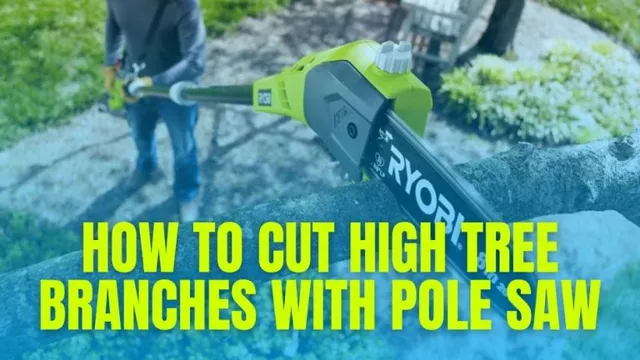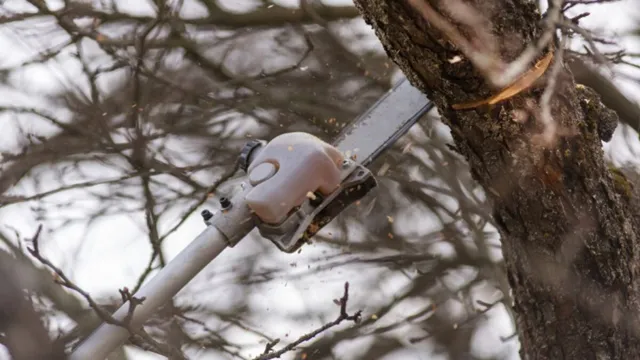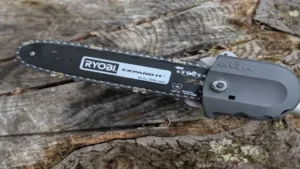Do you have trees that need trimming but don’t want to climb a ladder or invest in expensive equipment? Cutting tree branches with a pole saw might be the solution for you. These long-handled saws allow you to prune or remove branches from a safe distance while still maintaining control and accuracy. In this how-to guide, we’ll cover everything you need to know about using a pole saw to cut tree branches.
From selecting the right pole saw for your needs to maintaining it for longevity, we’ll provide tips and tricks to help you safely and efficiently trim your trees. So, let’s get started and get those unruly branches under control.
What is a Pole Saw and Why Use It?
If you’re wondering how to cut branches that are too high up, a pole saw might be your solution. A pole saw is a tool that consists of a saw blade attached to a long pole that extends your reach so you can trim branches without using a ladder. It’s a handy tool for gardeners, landscapers, and homeowners who want to maintain their trees’ health and appearance.
Unlike other tools such as a chainsaw, a pole saw is lightweight and easy to maneuver, making it ideal for those hard-to-reach places. You won’t need to worry about losing your balance on a ladder while trimming branches, which reduces the risk of accidents. However, it is essential to use proper techniques and safety measures when using a pole saw to avoid injuries or damage to the tree.
So, the next time you need to trim a branch, consider using a pole saw for a safer and more efficient cutting experience.
Definition and Types
A pole saw is a gardening tool that can be used for pruning and trimming trees or branches. It consists of a saw blade attached to a long pole, allowing the user to reach higher areas without using a ladder or climbing a tree. There are several types of pole saws available, including manual pole saws, electric pole saws, and gas-powered pole saws.
Manual pole saws are powered by the user and are great for small jobs but can be tiring for larger projects. In contrast, electric and gas-powered pole saws are more convenient and can handle bigger jobs, making them popular among professionals and homeowners alike. Using a pole saw is not only more efficient but also safer since it minimizes the need for climbing ladders or trees.
Whether you’re a professional arborist or a homeowner looking to maintain your trees, a pole saw can be a great investment in your gardening tool collection.

Benefits of Using a Pole Saw for Branch Cutting
A pole saw is a specialized cutting tool that’s designed for trimming tree branches that are out of reach. It’s a long pole with a saw blade that’s mounted at the end, allowing you to easily cut branches that are higher up without the need for a ladder. Not only does this save you time and effort, but it also makes the job safer by reducing the risk of falls or injuries.
Using a pole saw for branch cutting is especially beneficial for those with large yards or gardens, as it enables you to maintain your trees without having to hire a professional arborist. Organic keyword: Pole saw.
Preparing for Branch Cutting with a Pole Saw
Are you preparing to cut branches with a pole saw but not quite sure where to start? First, make sure your pole saw is in good working condition and has a sharp blade. Then, survey the tree and identify the branches you want to remove. Next, determine if any of the branches are under tension or pressure from the weight of the tree or other branches.
These branches will require special attention and cutting techniques. Make sure to clear the area around the tree and any potential fall zones. When cutting, start at the base of the branch and make a notch on the bottom side of the branch.
This notch will help guide the saw and prevent the bark from tearing. Cut from the top side of the branch to the bottom of the notch. Continue cutting until the branch breaks free.
Remember to take breaks and stay hydrated during the process. With these tips and proper safety precautions, you’ll be able to tackle those pesky branches with confidence using your pole saw.
Safety Precautions
When it comes to cutting branches with a pole saw, safety should always be a top priority. Before starting, it’s important to prepare yourself by wearing the appropriate safety gear. This includes a hard hat to protect your head from falling branches, safety glasses or goggles to shield your eyes from flying debris, and gloves to provide a better grip on the pole saw.
It’s also important to choose the right saw for the job and ensure it’s in good working order. Before starting to cut, survey the area for any potential hazards such as power lines, nearby buildings, or uneven terrain. Always work with a partner who can help guide the saw and assist in case of an emergency.
By taking these precautions, you can safely and efficiently trim branches without risking injury to yourself or others. Remember, a little preparation can go a long way in ensuring a safe and successful cutting experience.
Evaluating the Tree and Branches
Preparing for Branch Cutting with a Pole Saw – Evaluating the Tree and Branches Before you start using your pole saw to cut branches off a tree, it’s important to carefully evaluate the tree and its branches. Check to see if there are any dead or diseased branches that need to be removed first, as these can be hazardous and can compromise the health of the tree. Look for any branches that are crossing or rubbing against each other, as these can become weakened or damaged over time.
You should also look for branches that are growing too close to power lines or other structures, as these can pose a safety risk. Once you’ve identified the branches that need to be removed, you can begin preparing for the branch cutting process. Make sure you have a stable ladder or sturdy platform to stand on, and always work with a partner to ensure your safety.
It’s also important to choose the right type of pole saw for the job, based on the height and thickness of the tree branches you’ll be cutting. When using your pole saw to cut branches, be sure to start at the base of the branch and work your way outwards towards the tip, making clean, even cuts along the way. Avoid cutting too close to the tree trunk or leaving any jagged edges that can invite disease or pests.
Overall, using a pole saw to cut branches can be a safe and efficient way to maintain the health and appearance of your trees. Just be sure to evaluate the tree and branches carefully beforehand, and follow proper safety precautions while cutting.
Choosing the Right Pole Saw and Accessories
If you’re planning on tackling some branch cutting around your property, investing in a good pole saw and its accessories is essential. There are a few things to consider when choosing the right pole saw, such as the reach you’ll need, the size of branches you’ll be cutting, and whether you prefer a gas or electric model. Once you’ve selected your pole saw, it’s important to prepare for the task ahead.
Make sure you have protective gear like gloves, eye and ear protection, and appropriate clothing. You should also clear the area around where you’ll be working and confirm there are no obstacles that could interfere with your cutting. By taking these steps, you can ensure a safe and successful experience using your pole saw to trim branches and keep your property looking its best.
Cutting Techniques for Branches with a Pole Saw
When it comes to cutting branches with a pole saw, there are a few techniques to keep in mind to ensure efficiency and safety. One important thing to remember is to always start with the lower branches first, working your way up to higher branches. This allows easier access to the higher branches and reduces the risk of the saw getting tangled in lower branches.
Another technique is to use the saw at a right angle to the branch, rather than sawing directly from above. This helps prevent the saw blade from getting stuck and makes it easier to control the cut. Additionally, it’s important to never cut above shoulder height, as this can lead to loss of balance and potential accidents.
With these tips in mind, you can feel confident in using your pole saw to trim and maintain trees in your yard.
Positioning Yourself and the Pole Saw Correctly
When using a pole saw, it’s important to position yourself and the saw correctly in order to safely and effectively remove branches from trees. To start, make sure you have a stable and sturdy position on the ground. Then, extend the pole saw to its fullest length and locate the branch you want to cut.
Move the saw into position so that the blade is above the branch, but not too close to the trunk. Once in position, use a slow and steady motion to begin cutting through the branch, starting from the top and working your way down. Keep in mind that the weight of the branch can cause it to swing or fall, so be sure to clear the area of people and property before making any cuts.
With a little practice and attention to detail, you’ll be able to safely and confidently use a pole saw to keep your trees and property in top shape.
Starting the Cut on the Branch
When preparing to cut a branch with a pole saw, it’s important to start the cut correctly to ensure a clean and safe cut. To begin, position your pole saw at an angle so the blade rests on the branch where you want to make your cut. It’s essential to start the cut on the branch’s underside, which means you’ll need to position yourself on the opposite side of the branch.
With a firm grip on the pole saw, use a smooth and controlled motion to begin your cut. Make sure you’re applying pressure steadily to avoid any slipping of the blade. Furthermore, be wary of any obstacles that could interfere with your cut, such as twigs or other branches that could cause the saw to bind.
With practice and patience, you’ll be able to master this cutting technique efficiently and safely. So go ahead, confidently start the cut on the branch with your pole saw and enjoy the satisfaction of a well-done job.
Continuing the Cut with Proper Pressure and Angles
When it comes to cutting branches with a pole saw, it’s important to continue the cut with proper pressure and angles. Once you’ve identified the branch you want to cut, approach it from the underside to prevent it from splitting. Apply slight pressure to the saw and use a gentle back-and-forth motion until the blade makes an initial cut.
Then, gradually increase pressure and saw in a sweeping motion to complete the cut. It’s important to maintain a sharp blade and proper angle while cutting to prevent unnecessary strain on the saw and to ensure a clean cut. Think of it like slicing bread- use a sharp knife at the correct angle and apply pressure as needed to create a clean, even slice.
By following these cutting techniques, you can safely and effectively trim branches with your pole saw.
Finishing the Cut and Removing the Branch
When it comes to cutting branches with a pole saw, finishing the cut and removing the branch require a bit of technique. Once you’ve made the initial cut on the branch, you’ll need to move the saw away from the branch to let it fall. Don’t pull the saw back towards you, as this can damage the branch and leave it hanging precariously.
Once the branch has fallen to the ground, use the saw to remove any remaining pieces. Be sure to wear gloves to protect your hands during this process. Your pole saw should have a safety feature that prevents the blade from accidentally engaging, but it’s always best to err on the side of caution.
By following these tips, you’ll be able to finish the job safely and efficiently.
Additional Tips for Efficient Branch Cutting with a Pole Saw
Cutting branches with a pole saw is an easy task once you know how to use it properly. However, if you want to become an efficient branch cutter, you need to follow some additional tips. Firstly, make sure you are standing comfortably and firmly on the ground.
A stable position will enable you to reach high branches without losing balance or footing. Secondly, keep the pole saw blade sharp and well oiled. This will not only give you a cleaner cut but also reduce wear and tear of your equipment.
Remember, maintaining your tool is essential for its longevity. Thirdly, cut branches at a 45-degree angle to promote proper healing. A diagonal cut allows rainwater to fall off the branch, preventing rot and decay.
Lastly, use your body weight to apply pressure while cutting larger branches. Leverage the weight of the pole saw to your advantage, and let gravity do the job. Following these tips will ensure you a more effortless, efficient, and enjoyable branch cutting experience.
Maintaining the Pole Saw and Accessories
When using a pole saw for branch cutting, it’s important to keep the equipment maintained and in good condition to ensure efficient operation. One key tip is to make sure the blade is sharp and free from debris before every use. Dull blades can cause added strain on the motor and make it more difficult to cut through branches.
Additionally, using accessories like saw oil can help keep the blade lubricated and prevent it from getting stuck in the wood. Another helpful tip is to adjust the length of the pole saw according to the height of the branches being cut. This will help prevent overreaching and reduce the risk of injury.
Remember, proper maintenance and attention to detail can make all the difference in achieving a successful and safe branch-cutting experience with your pole saw.
Avoiding Common Mistakes
When using a pole saw to cut branches, there are a few common mistakes that people make which can be easily avoided with some additional tips. Firstly, it’s important to ensure that the saw is well-maintained and sharp so that it can efficiently cut through branches without causing any damage. Additionally, it’s helpful to have a good vantage point when using the pole saw so that you can clearly see where you’re cutting.
When cutting branches, it’s best to start from the outer edge of the branch and work your way inwards, taking care not to cut too close to the trunk. Finally, it’s important to keep safety in mind at all times when using a pole saw. This means wearing protective gear such as gloves and safety glasses, as well as being aware of your surroundings and avoiding working near power lines or electrical equipment.
By following these tips, you can ensure that your branch cutting is efficient, safe, and effective.
Seeking Professional Help When Necessary
If you’re a homeowner with trees on your property, you may need to prune or trim branches from time to time. While using a pole saw can make the job easier, it’s important to take the necessary safety precautions and follow some tips for efficient branch cutting. One helpful hint is to start cutting from the outside of the branch and work your way inwards, using small cuts to prevent the branch from breaking off suddenly.
Another useful piece of advice is to lubricate the blade with some oil to prevent it from getting stuck in the wood. Of course, if you don’t feel comfortable using a pole saw or the branches are too large or too high up for you to safely reach, it’s always best to consult a professional tree service. They have the tools and expertise to handle the job safely and efficiently, minimizing risks to both you and your property.
Remember, safety always comes first when it comes to tree trimming and removal.
Conclusion
In conclusion, using a pole saw to cut branches can be a breeze if you follow these simple steps. Remember to choose the right tool for the job, wear proper safety gear, plan your cuts carefully, and maintain good posture throughout the process. With these tips and a little bit of patience, you’ll be pruning those unwanted branches like a pro in no time.
And if you’re feeling stuck, just remember the wise words of George Washington Carver: ‘Learn to do common things uncommonly well.’ So grab that pole saw, get out there, and make your tree the best it can be!”
FAQs
What is a pole saw and how does it work?
A pole saw is a type of saw that has a long handle or pole which extends to reach high branches. It works by using a cutting blade attached to the end of the pole which is operated by pulling on a rope or using a chain mechanism.
What are the different types of pole saws available in the market?
There are different types of pole saws available such as manual pole saws, electric pole saws, and gas-powered pole saws. Manual pole saws require physical effort to operate, whereas electric and gas-powered pole saws are powered by electricity or gas respectively.
How do I choose the right pole saw for cutting branches?
When choosing a pole saw, consider the height and thickness of the branches you need to cut, the frequency of use, and your physical ability to handle the weight and length of the saw. Also, consider the power source and the cost of the saw.
What safety measures should I take when using a pole saw?
Always wear protective gear such as safety glasses, gloves, and a hard hat. Ensure the pole saw is in good condition and the blade is sharp. Keep the saw away from power lines and avoid using it in wet conditions or on unstable ground. Use both hands to operate the saw and avoid cutting above your head.
How often should I sharpen the blade of my pole saw?
The frequency of sharpening depends on the amount of use and the type of wood you are cutting. However, a general guideline is to sharpen the blade after every 10-12 hours of use.
How do I maintain my pole saw?
Regular maintenance ensures the longevity of the pole saw. Keep the blade clean and sharp, lubricate the chain periodically, tighten loose screws and bolts, and store the saw in a dry place.
Can I use a pole saw to cut down a whole tree?
Pole saws are designed to cut branches, not whole trees. Attempting to cut down a tree with a pole saw is dangerous and can result in serious injury or property damage. Always hire a professional arborist for tree removal.






